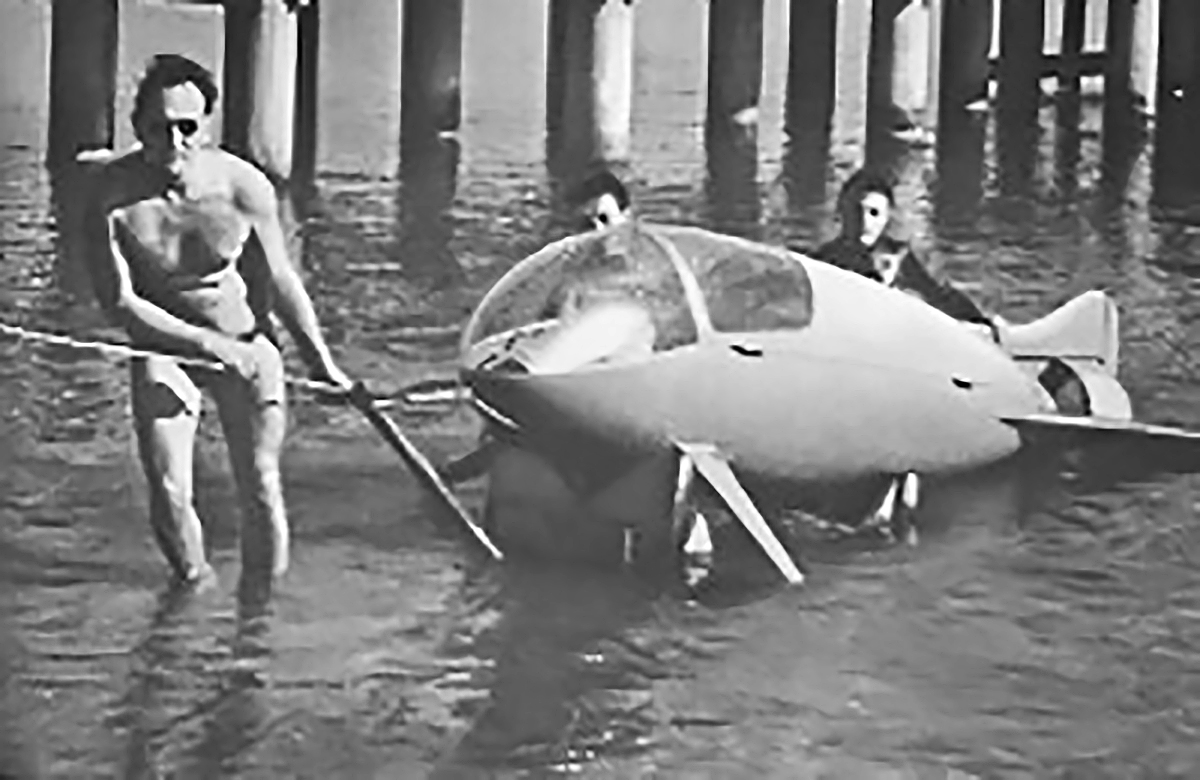In the years when scuba diving was taking its first steps, many families who had fled Russia during the revolution lived in France. And two Russian names appear among the greatest protagonists of that exciting season of discoveries and inventions that gave birth to extraordinary scuba equipment for the time, the same equipment that later developed to become common today. The two are Alec Kramarenco, about whom David Wilson wrote last August, and Dimitri Issaievitch Rebikoff, to whom this month's article in the Historical Characters section is dedicated.
Born in 1921, Rebikoff graduated at the Sorbonne University in Paris, then moved to Switzerland where, in Lausanne, he opened an engineering cabinet and got married. In 1950, he invented the electronic flash, the Eclatron, patented in France and Switzerland, then he positioned it inside a case to use it underwater for industrial and scientific goals. He had an immediate success, and he quickly sold several thousand units.

fig. 1 - Il flash Eclatron
Two years after, invited by the Club Alpin Sous-Marin to realize something for the recreational divers, he created a monobloc system consisting of a small-format camera in a case, equipped with a lens corrected for use underwater, and his Eclatron. Modern underwater photography was born.
In 1952, Rebikoff presented the famous Torpille, a small underwater individual vehicle with the shape of a torpedo, the progenitor of underwater scooters.
Torpille soon brought to Pegasus born in 1953, equipped with handles, supports for the underwater camera and electronic flash. It was projected to be both piloted by a diver and remotely operated, offering scientists and researchers a means that could be sent to take photographs of any wreck or seabed. It was renamed “chien sous-marin” (underwater dog) because its long remotely-controlled cable seemed a dog on a leash.

fig. 2 - La Torpille |

fig. 3 - Rebikoff col Pegaso - ph. William G. Schulz |

fig. 4 - Rebikoff - Il Pegasus |

fig. 5 - Rebikoff - Il Pegasus |
In this period, Jacques-Yves Cousteau asked for Rebikoff’s cooperation for these competences in the sectors of diving illumination, lenses, cases for video-photo apparatus, vehicles for underwater navigation. This cooperation soon showed to be essential in the realization of the movie The world without sun and several other documentaries.
|
These are years of big enthusiasm for underwater hunting; spearguns are born of all kinds, and also Rebikoff cooperates to design a strange model which will be patented in Paris in 1955. It has elastics and has the advantage of requiring minimal effort to reload. At the beginning, this occurs in the traditional way, then the tension of the double elastic is advanced with a ratchet system along a rack, acting in steps on the lever integrated in the handle.

fig. 8 - Pubblicità del fucile Rebikoff |

fig. 9 - L'impugnatura con la leva di caricamento |
In 1960, Rebikoff with his Swiss wife Ada Niggeler, her extraordinary scientific partner moved to Nice, in the French Riviera, in a villa on the seashore with a small pier in front where his boat was moored. An ideal accommodation that allowed him to immediately try out his intuitions and inventions in the water.
Torpille, further improved, was enriched with depth gauge and tachometer, besides other instruments typical of aviation such as the artificial horizon and the gyrocompass. In this way, diver could navigate without visual references and in any visibility condition, so that Torpille in this version was further renamed Avion sous-marin, underwater airplane.
Early 70s he moved to the United States of America, where he founded the Rebikoff Underwater Products in Fort Lauderdale, Florida; he worked for US Navy in the field of underwater shots. In this period, he published several diving photo books, among them the famous Underwater Photography in 1975. Later, he dedicated also to the historical researches together with the archeologist of Rumanian origin, Doru Todericiu, known by the pseudonym of Pierre Carnac. He developed a new model of underwater scooter, the “Remora M-114-E”, with which he explored the so-called Bimini Road, the underwater rock formation on the seabed around the island of Bimini in the Bahamas that has inspired many stories and legends.
In the next decade, he continued to focus his interest in underwater photography and exploration, and he opened the Institute of Marine Technology with his wife Ada. Born as non-profit association dedicated to the research and development of underwater photography and cinematography, it is still active with headquarters in the Azores under the name of Rebikoff-Niggeler Foundation.
Dimitri Rebikoff died in 1997, leaving an indelible mark on the field of underwater photography and means for exploring the seabed.
_______________

